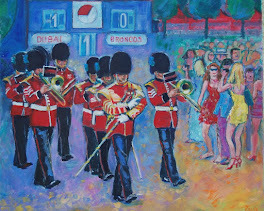The Chelsea and Westminster Hospital, in Chelsea, London, has an unexpectedly interesting and stimulating collection of art. I saw it when visiting the hospital this month.
In the 'gallery', which is a long display area on the first floor, are works by Dominic Madden and James Martelli.
Hospital Arts at Chelsea and Westminster Hospital
Friday 17 December 2010
BACK FROM JAMAICA, AND WISHING I WAS THERE WHEN VISITING THE GAUGUIN EXHIBITION AT THE TATE MODERN.
PAUL GAUGUIN, MAKER OF MYTH - TATE MODERN - UNTIL 16 JANUARY 2011.
I went to the big (or rather medium sized) exhibition at the Tate Modern yesterday afternoon. As the weather was dire, and everybody preoccupied with Christmas parties and shopping, there was no queue, despite the Tate web site giving dire warnings that it is essential to prebook.
I walked straight in, on the 4th floor of the Tate, and found the people inside were quite thinly distributed. although a lot were collected on the various benches, probably absolutely exhausted.
I do not recall visiting the previous Gauguin shows in London, though of course I have seen a lot of the paintings in mixed exhibitions. Some of the work was completely new to me, and I noted several from Russian collections.
There was a couple of rooms showing the background to his decision to visit the tropics, - letters - photos of Tahiti for example. Also examples of his wood block prints, and other graphic productions, and examples of the journal he published, called La Sourire. In room 4 are some of his drawings. I got the impression that he struggled and was obsessive, endeavoring to conquer the various mediums.
Dotted around in the rooms are some of Gauguin's wood carvings, and ceramic figures, and the huge door-surround which he constructed and carved in the Marquesas.
Maybe Gauguin was a man who was trying anything which he fancied? There was a lot of bits and pieces, a little carving, a little pottery, some lithographs etc plus several styles of painting.
In Room 7 is a beautiful study, called Head of 2 Marquesans, described as 'Traced Monotype' 1902 from the British Museum collection. The heads are used in a painting called The Escape, 1902, from Prague. The colours are browns, golds, pinky red, blue, green. Absolutely, it works.
Painting, I presume, was his main preoccupation. I have not read his letters or any books on him, so I am unable to back up this statement. However, the styles vary a lot, that which I admired most was beautiful portraiture of the girls in the tropics.
There are some magnificent paintings, particularly in Room 9, where are hung five beauties. In particular the painting Aha oe Fii? (What, are you jealous?), (1892) seems to vibrate with light and depth. The figures rounded and delicious. Colours almost edible and chocolaty.
These are the paintings, in this room 9, that I would love to take home. In this room are: Two Tahitian Women, 1899, from New York Met, and Tehamana has many Parents, 1893, from the Art Institute of Chicago., and Eu Haere ia oe (Woman holding a fruit), 1892, from the Hermitage, St Petersburg.
There were others, of course, that I admired. Particularly interesting was the use of bright bluish pinks, yellow-greens, and the pale blue of tropical seas, used as clothing and in the landscape backgrounds. I wonder how he came by the pigments, being so far from main artists suppliers; maybe he sent for them to be delivered by ship? The paintings seemed to be in good condition, considering their possible lack of care after Gauguin died in the Marquesas.
I have just returned from a holiday in Jamaica, near Ocho Rias, and I thought longingly of the beautiful sky there, the black night with its stars, the luscious sea-grape trees, the ginger lilies and all the other delicious tropical green shrubs and flowers. I can see why Gauguin painted those people, those greens and blues, and the strong, dark contrasts and shadows. Wish I was back in Jamaica!
Subscribe to:
Posts (Atom)






